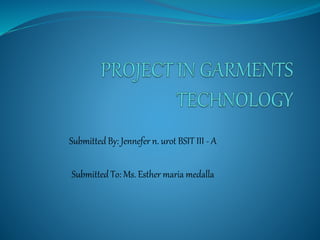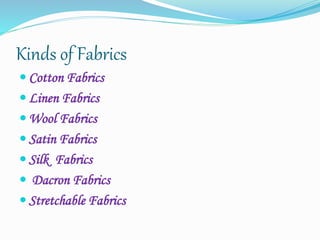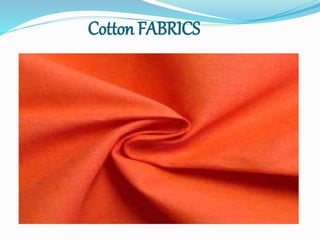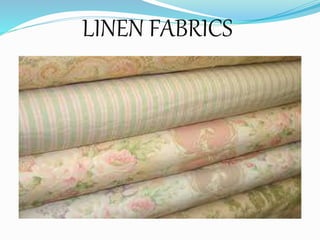The document provides information about different types of fabrics, including cotton, linen, wool, satin, silk, dacron, and stretchable fabrics. For each fabric type, the document discusses the material it is made from, its properties, common uses, and background information. Key details provided include that cotton is soft, breathable and absorbs moisture; linen is cool and lightweight; wool is insulating, flame resistant and moisture absorbent; satin has a glossy surface; silk originates from silkworm cocoons and is elegant and versatile; dacron is a trade name for polyester fabric; and stretchable fabrics can stretch in all directions using materials like spandex.








![ Linen is a textile made from the fibers of the flax plant, Linum usitatissimum. Linen is labor-
intensive to manufacture, but when it is made into garments, it is valued for its exceptional
coolness and freshness in hot weather.
Textiles in a linen-weave texture, even when made of cotton, hemp and other non-flax fibers
are also loosely referred to as "linen". Such fabrics generally have their own specific names
other than linen; for example, fine cotton yarn in a linen-style weave is called Madapolam.
The collective term "linens" is still often used generically to describe a class of woven and even
knitted bed, bath, table and kitchen textiles. The name linens is retained because traditionally,
linen was used for many of these items. In the past, the word "linens" was also used to mean
lightweight undergarments such as shirts, chemises, waist shirts, lingerie (a word which is
cognate with linen), and detachable shirt collars and cuffs, which were historically made
almost exclusively out of linen.
Linen textiles appear to be some of the oldest in the world: their history goes back many
thousands of years. Fragments of straw, seeds, fibers, yarns, and various types of fabrics which
date back to about 8000 BC have been found in Swiss lake dwellings. Dyed flax fibers found in
a prehistoric cave in Georgia suggest the use of woven linen fabrics from wild flax may date
back even earlier to 36,000 BP.[1][2]
Linen was sometimes used as currency in ancient Egypt. Egyptian mummies were wrapped in
linen because it was seen as a symbol of light and purity, and as a display of wealth. Some of
these fabrics, woven from hand spun yarns, were very fine for their day, but are coarse
compared to modern linen.[3]
Today linen is usually an expensive textile, and is produced in relatively small quantities. It has
a long "staple" (individual fiber length) relative to cotton and other natural fibers.[4]
Many products are made of linen: apron, bags, towels (swimmers, bath, beach, body and wash
towel), napkins, bed linen, linen tablecloth, runners, chair cover, men's and women's wear.](https://image.slidesharecdn.com/fabrics-160816045952/85/Fabrics-9-320.jpg)


![ Wool is the textile fiber obtained from the hair of sheep and certain other animals,[1] including
cashmere from goats, mohair from goats, vicuña, alpaca, and camel from animals in the camel family,
and angora from rabbits.[citation needed]
Wool has several qualities that distinguish it from hair or fur: it is crimped, it is elastic, and it grows in
staples (clusters).[2]
Wool's scaling and crimp make it easier to spin the fleece by helping the individual fibers attach to
each other, so that they stay together. Because of the crimp, wool fabrics have a greater bulk than
other textiles, and retain air, which causes the product to retain heat. Insulation also works both ways;
Bedouins and Tuaregs use wool clothes to keep the heat out.
The amount of crimp corresponds to the fineness of the wool fibers. A fine wool like Merino may have
up to 100 crimps per inch, while the coarser wools like karakul may have as few as 1 to 2. Hair, by
contrast, has little if any scale and no crimp, and little ability to bind into yarn. On sheep, the hair
part of the fleece is called kemp. The relative amounts of kemp to wool vary from breed to breed, and
make some fleeces more desirable for spinning, felting, or carding into batts for quilts or other
insulating products.
Wool fibers are hygroscopic, meaning they readily absorb moisture. Wool can absorb moisture almost
one-third of its own weight.[3] Wool absorbs sound like many other fabrics. Wool is generally a creamy
white color, although some breeds of sheep produce natural colors such as black, brown, silver, and
random mixes.
Wool ignites at a higher temperature than cotton and some synthetic fibers. It has lower rate of flame
spread, low heat release, low heat of combustion, and does not melt or drip;[4] it forms a char which is
insulating and self-extinguishing, and contributes less to toxic gases and smoke than other flooring
products, when used in carpets.[5] Wool carpets are specified for high safety environments, such as
trains and aircraft. Wool is usually specified for garments for fire-fighters, soldiers, and others in
occupations where they are exposed to the likelihood of fire.[5]
Wool is resistant to static electricity, as the moisture retained within the fabric conducts electricity.
This is why wool garments are much less likely to spark or cling to the body. The use of wool car seat
covers or carpets reduces the risk of a shock when a person touches a grounded object. Wool is
considered by the medical profession to be hypoallergenic.](https://image.slidesharecdn.com/fabrics-160816045952/85/Fabrics-12-320.jpg)


![ Satin is a weave that typically has a glossy surface and a dull back. It is a
warp-dominated weaving technique that forms a minimum number of
interlacings in a fabric. Some definitions insist that the fabric be made
from silk.[1] If a fabric is formed with a satin weave using filament fibres
such as silk, nylon, or polyester, the corresponding fabric is termed a
satin. If the yarns used are short-staple yarns such as cotton, the fabric
formed is considered a sateen.
A satin-woven fabric tends to have a high luster due to the high number
of floats on the fabric. Floats are missed interlacings, where the warp
yarn lies on top of the weft yarn, or vice versa. The floats tend to make
the fabric look glossier as well as give it a smoother surface.
Many variations can be made of the basic satin weave including a
granite weave and a check weave. Satin weaves, twill weaves, and plain
weaves are the three basic types of weaving by which the majority of
woven products are formed.
Satin is commonly used in apparel: satin baseball jackets, athletic
shorts, women's lingerie, nightgowns, blouses and evening gowns, but
also in some men's boxer shorts, shirts and neckties. It is also used in
the production of pointe shoes for use in ballet. Other uses include
interior furnishing fabrics, upholstery, and bed sheets.
Originally, during the middle ages, satin was made of silk;
consequently it was very expensive, used only by the upper classes.](https://image.slidesharecdn.com/fabrics-160816045952/85/Fabrics-15-320.jpg)









